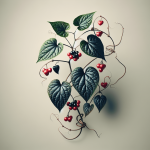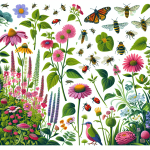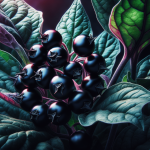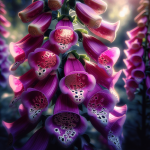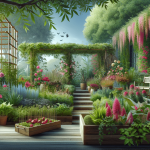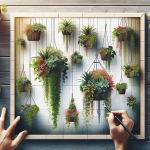This post may contain affiliate links. As an Amazon Associate, we may earn commissions from qualifying purchases.
With the growing concern over water scarcity and environmental sustainability, finding ways to conserve water in your garden is becoming increasingly important. In this article, you will discover practical and simple methods to lessen water usage while still maintaining a lush and vibrant garden. From utilizing efficient watering techniques to choosing the right plants for your climate, we’ll explore various strategies that can help you save water and make a positive impact on the environment.
Choose Drought-Tolerant Plants
When it comes to conserving water in your garden, one of the best steps you can take is to choose drought-tolerant plants. These are plants that can thrive with less water, meaning you won’t have to constantly irrigate them to keep them healthy. By selecting plants that require less water, you can significantly reduce your water usage and still have a beautiful garden.
To start, it’s important to research and select plants that are known for their low water needs. Look for species that are well-suited to your region’s climate. Native plants, in particular, are great options to consider. These are plants that have adapted to the local climate over time and are naturally resilient to drought conditions. Planting native species not only helps conserve water but also supports the local ecosystem by providing food and habitat for native wildlife.
Additionally, choosing plants with low water needs can make a big difference in water conservation. Look for varieties that are known for their ability to thrive in arid environments. Succulents, for example, store water in their leaves, making them excellent choices for water-efficient gardening. Other examples include lavender, yarrow, and sage. By opting for plants with low water requirements, you can ensure that your garden remains beautiful even in times of water scarcity.
Improve Soil Quality
The quality of your garden’s soil plays a crucial role in water conservation. If the soil is not able to retain water effectively, much of it can be lost through runoff or evaporation. By improving soil quality, you can enhance its water retention abilities and reduce the need for frequent watering.
adding organic matter to the soil is an effective way to increase water retention. Organic matter, such as compost, peat moss, or well-rotted manure, improves the soil structure and helps it hold onto water for longer periods. Mix in organic matter when preparing your planting beds or consider top-dressing existing beds annually to continually improve soil quality.
Another technique to conserve water in the garden is mulching. By applying a layer of organic mulch, such as wood chips or straw, to the soil surface, you can prevent moisture loss through evaporation. Mulch acts as a protective barrier, keeping the soil cool and preventing water from evaporating too quickly. This not only helps conserve water but also reduces the need for frequent watering.
Additionally, using compost can significantly boost soil fertility. This is important because fertile soil can support healthier and more resilient plants. By incorporating compost into your soil, you’ll be enhancing its ability to retain moisture and provide adequate nutrients to your plants. This, in turn, will reduce the need for excessive watering and promote better overall plant growth.
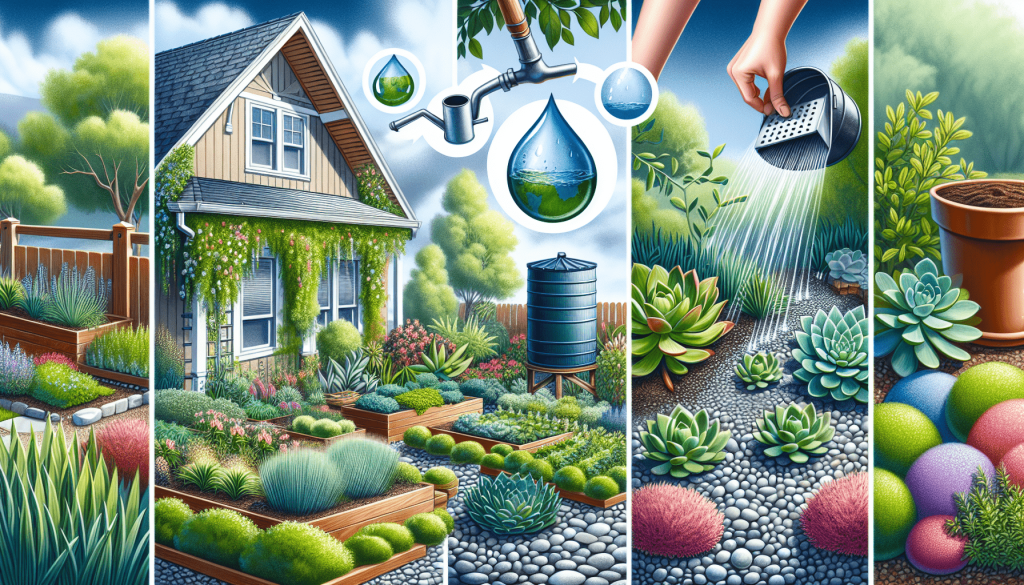
Water Efficiently
When it comes to watering your garden, efficient practices can go a long way in conserving water. By making a few adjustments to your watering routine, you can ensure that your plants receive adequate moisture while minimizing water waste.
Watering deeply but less frequently is a key strategy to promote strong, drought-resistant root growth. By delivering water directly to the root zone, plants are encouraged to develop deeper root systems, enabling them to access water stored deeper in the soil. This means you won’t have to water as frequently since the roots can reach the water they need more effectively.
To avoid overwatering, it’s important to check moisture levels before watering. Stick your finger into the soil a few inches deep to determine if it is dry or still moist. If the soil feels moist, there’s no need to water just yet. By monitoring soil moisture, you can prevent unnecessary watering and ensure that water is being used efficiently.
When it comes to the method of irrigation, consider using soaker hoses or drip irrigation systems. These methods deliver water directly to the root zone, minimizing evaporation. Soaker hoses slowly release water along their length, allowing for deep penetration into the soil. Similarly, drip irrigation systems deliver water through emitters or drip lines, providing targeted watering to individual plants. These systems not only conserve water but also reduce the risk of overwatering and weed growth.
Timing your watering is also crucial for water conservation. Watering in the early morning or late afternoon is recommended because these are the cooler parts of the day with less evaporation. By avoiding midday watering, when temperatures are higher and evaporation rates are increased, you can reduce water loss and ensure your plants are getting the maximum benefit from each watering session.
Additionally, consider collecting rainwater to use for irrigation. Installing a rain barrel or rainwater harvesting system allows you to capture and store rainwater during wet periods to be used during drier times. This is not only a sustainable way to conserve water but also helps reduce your water bill.
Use Smart Irrigation Techniques
In addition to efficient watering practices, using smart irrigation techniques can further maximize water conservation in your garden. These techniques involve implementing various measures and technologies to ensure that water is used efficiently and not wasted.
Installing a rain sensor is one such measure. A rain sensor is a device that detects rainfall and automatically shuts off irrigation systems during or after rain events. By preventing unnecessary watering when nature has already provided sufficient moisture, rain sensors help conserve water and prevent overwatering.
Another option to consider is weather-based irrigation controllers. These controllers use weather data, such as temperature and rainfall amounts, to automatically adjust watering schedules. They ensure that plants receive the appropriate amount of water based on prevailing weather conditions, avoiding excessive watering during rainy periods and adjusting for hotter and drier seasons.
Grouping plants with similar water needs together is another effective technique for efficient watering. By creating “hydrozones,” you can ensure that plants with higher water requirements are located in the same area. This allows for targeted watering, as those plants can receive the appropriate amount of water without wasting it on plants that require less. Hydrozoning also makes it easier to adjust watering schedules and ensures that each plant receives the optimal amount of water for healthy growth.
Finally, it’s important to adjust irrigation schedules based on seasonal changes. During spring and fall, when temperatures are milder and rainfall is typically more abundant, plants may require lesser amounts of water. As temperatures rise in the summer, adjustments to watering schedules may be necessary to meet increasing water demand. By regularly reviewing and modifying your irrigation schedules throughout the year, you can ensure that water is used efficiently and avoid unnecessary waste.
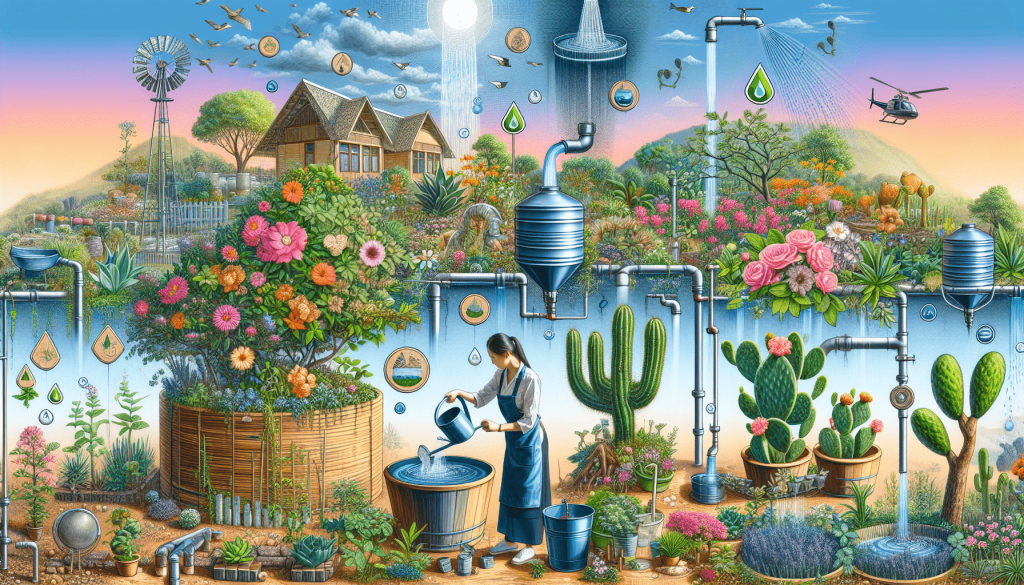
Implement Water-Saving Techniques
Implementing water-saving techniques in your garden can have a significant impact on water conservation. By making conscious choices in your landscaping design and maintenance practices, you can minimize water usage while still creating a beautiful and sustainable outdoor space.
One approach to consider is xeriscaping, which involves using rocks, gravel, or drought-resistant plants in specific areas of your garden. By replacing water-thirsty turfgrass or flowers with low-water alternatives, you can significantly reduce your water needs. Xeriscaping not only helps conserve water but also reduces the time and effort required for maintenance. It is particularly advantageous in arid regions or areas prone to drought.
Creating swales or berms is another water-saving technique. These features are designed to capture and retain rainwater, allowing it to slowly infiltrate the soil rather than running off. Swales are shallow, broad ditches, while berms are mounds of soil. By incorporating these elements into your landscape, you can minimize water runoff, promote water infiltration, and provide your plants with a self-sustaining source of water during dry periods.
Installing a drip line irrigation system can also make a significant difference in water conservation. Instead of using sprinklers that can result in significant water loss through evaporation, a drip line system delivers water directly to the base of plants. This targeted watering method ensures that water reaches the roots where it is needed most, making it incredibly efficient and water-saving.
In your garden maintenance routine, consider using a broom instead of a hose to clean paved areas. Sweeping away debris and dirt with a broom is not only more effective but also helps conserve water. Hose usage can lead to unnecessary water waste, whereas a broom allows you to keep your garden clean while minimizing water consumption.
Lastly, avoid using sprinklers in windy conditions. Wind can cause water to disperse and drift away from your intended target, resulting in significant water wastage. By being mindful of weather conditions and avoiding irrigation during windy periods, you can ensure that your water is being used effectively and not lost to evaporation or runoff.
Monitor and Maintain Irrigation Systems
Regular monitoring and maintenance of your irrigation systems are essential for water conservation. By keeping your systems in good working order, you can detect any issues or inefficiencies early on and prevent excessive water waste.
Regularly check for leaks or damaged components in your irrigation system. Leaks in pipes or fittings can result in significant water loss over time, so it’s important to fix them as soon as possible. Inspect all the components, such as sprinkler heads, valves, and drip emitters, to ensure they are functioning properly and not wasting water.
Adjusting sprinkler heads is another important step in minimizing overspray onto non-landscaped areas. Make sure the spray patterns are adjusted to avoid watering sidewalks, driveways, or other hardscapes. Properly directed water ensures that it’s being used efficiently and not wasted on areas that don’t require irrigation.
Clean or replace clogged nozzles or filters in your irrigation system regularly. Over time, small particles or debris can accumulate in the system, obstructing water flow and reducing efficiency. By cleaning or replacing these components, you can ensure that water distribution is uniform and optimal.
Lastly, ensure proper coverage and distribution of water in your garden. Make sure all areas are receiving adequate water, and adjust your system if you notice any dry or overly saturated spots. Proper coverage will ensure that all plants receive the necessary amount of water for healthy growth and minimize the risk of water waste.
Practice Water-Smart Planting
Water-smart planting techniques can significantly contribute to water conservation in your garden. By carefully planning and arranging your plants, you can maximize water efficiency and reduce water loss due to evaporation or runoff.
As mentioned earlier, grouping plants with similar water needs together is key to efficient watering. By creating hydrozones, you can tailor your watering to meet each plant’s specific requirements. This ensures that water is being used effectively and not wasted on plants that don’t need as much moisture.
Another strategy is to plant ground covers in your garden. These low-growing plants provide a protective layer that helps reduce soil erosion and slows down water evaporation. By covering bare soil with ground covers, you can conserve water and promote a healthier soil ecosystem.
Creating shade in your garden, whether through trees or artificial structures, can also help minimize direct sun exposure and reduce water loss. Shade provides a cooling effect, reducing evaporation rates and allowing your plants to retain moisture for longer periods. This is especially beneficial during hot summer months when plants are more prone to water stress.
If you prefer container gardening or have limited space, consider using planters or pots with moisture-retaining features. Some containers are designed with built-in reservoirs that capture and store excess water, gradually releasing it to the plant roots as needed. This can significantly reduce watering frequency while ensuring optimal moisture levels for your plants.
Consider Rain Gardens
Rain gardens are an excellent way to conserve water and promote sustainable landscaping. These gardens are designed to collect and absorb rainwater runoff, preventing it from flowing into storm drains or other waterways. By allowing the water to soak into the ground, rain gardens help replenish groundwater reserves and reduce the strain on municipal water supplies.
When creating a rain garden, it’s important to use native plants. Native species are adapted to the local climate and soil conditions, making them excellent choices for absorbing and utilizing rainwater efficiently. These plants have deep root systems that enhance water infiltration and help prevent erosion.
Proper grading and drainage are essential for optimizing rainwater capture in your garden. The rain garden should be designed to allow water to flow naturally into the designated area. Grading the soil to direct water toward the garden and ensuring proper drainage will ensure that rainwater is effectively captured and absorbed.
By considering a rain garden in your landscape design, you can create a functional and aesthetically pleasing feature while actively contributing to water conservation efforts.
Harvest and Reuse Water
Harnessing and reusing water from various sources is another effective way to conserve water in your garden. By collecting and repurposing water that would otherwise go to waste, you can reduce your reliance on fresh water sources and minimize your environmental impact.
One simple method is to collect and store rainwater in barrels or tanks. This water can be used for irrigating your garden during drier periods. Set up a rain barrel beneath a downspout or install a more elaborate rainwater harvesting system to capture significant amounts of rainwater. This not only reduces your water bill but also ensures that rainwater, a valuable resource, is put to good use.
Another option is to reuse household water, often referred to as graywater. Graywater is the wastewater generated from activities such as washing vegetables, dishes, or clothes. Instead of allowing this water to go down the drain, it can be repurposed for irrigating your garden. Simply collect the water in a designated container and use it to water your plants. Just be sure to avoid using graywater from sources that contain harmful chemicals or contaminants.
For a more extensive water reuse system, consider implementing graywater systems. These systems are designed to capture and treat wastewater from showers, sinks, or laundry, and then distribute it for landscape irrigation. While installation may require professional assistance, graywater systems are highly effective in conserving water and reducing reliance on freshwater resources.
Educate and Promote Water Conservation
Beyond implementing water-saving techniques yourself, it’s important to educate others and promote water conservation in gardening. By sharing knowledge and encouraging sustainable practices, we can all contribute to a more water-conscious society.
Start by educating yourself about the importance of water conservation in gardening. Read up on the latest research, attend workshops or webinars, and stay informed about emerging techniques and technologies. By building your own knowledge base, you can become an advocate for water conservation and share accurate and valuable information with others.
Spread the word about water-saving techniques to your friends, neighbors, and fellow gardeners. Share your success stories and inspire others to take action in their own gardens. Encourage them to choose drought-tolerant plants, improve soil quality, and adopt water-efficient practices. By collectively implementing small changes, we can make a significant impact on water conservation on a larger scale.
Consider participating in community programs or workshops focused on sustainable gardening practices. Many organizations and municipalities offer resources and events aimed at promoting water conservation and educating the public. By getting involved, you can further expand your knowledge and actively contribute to the conservation effort.
In conclusion, conserving water in the garden is not only essential for sustainability but also beneficial for your plants, wallet, and the environment. By choosing drought-tolerant plants, improving soil quality, watering efficiently, implementing smart irrigation techniques, practicing water-saving techniques, monitoring and maintaining irrigation systems, adopting water-smart planting strategies, considering rain gardens, harvesting and reusing water, and educating and promoting water conservation, you can make a significant difference in preserving this precious resource. Start implementing these practices today and enjoy a beautiful and sustainable garden while making a positive impact on our water supply.


